Assessment of Durability Indicators for Service Life Prediction of Portland Limestone Cementitious Systems Produced with Permeability-Reducing Admixtures
Abstract
1. Introduction
2. Materials and Methods
2.1. Materials
2.2. Specimen Preparation
2.3. Experimental Procedure
2.4. Electrical Resistivity
2.5. Effective Chloride Diffusion Coefficient
2.5.1. Definition and Significance
2.5.2. Assessment of the Effective Chloride Diffusion Coefficient from Non-Steady-State Migration Tests
2.5.3. Assessment of the Effective Chloride Diffusion Coefficient from Electrical Resistivity Measurements
2.6. Intrinsic Liquid Water Permeability
2.7. Shrinkage Strains
3. Results and Discussion
3.1. Results from Electrical Resistivity Measurements
3.2. Effective Chloride Diffusion Coefficient
3.3. Results from Water Permeability Measurements
3.4. Results from Drying Shrinkage and Thermal Expansion Measurements
3.5. Estimated Service Life
4. Conclusions
- Portland limestone cement mixtures with no plasticizing additives may exhibit lower strengths and higher drying shrinkage when the W/C ratio increases from 0.45 to 0.50.
- Portland limestone cement mixtures with a lower W/C ratio require additional effort or the addition of plasticizing admixtures to achieve the required level of compaction. Otherwise, durability may be impaired, as was proven in the present study by the higher chloride migration coefficients observed in specimens with lower W/C ratios.
- Incorporating CaCO3 in Portland limestone cement mortars may improve durability, reduce shrinkage, and lower compressive strength marginally. The mechanical and durability properties extensively depend on the material dispersion degree and, thus, the presence of supplementary admixtures with plasticizing properties that improve rheology and compaction.
- Good durability-related properties were pointed out for Portland limestone cement mortars containing butyl stearate and oleic acid, particularly where a 6% CaCO3 by weight of cement was incorporated. The effective chloride diffusion and intrinsic liquid water permeability were significantly lower than the reference specimen LC-R0.45 due to lower porosity. This further confirms the complementary nature of the two DIs to assess durability to potential corrosion.
- The thermal expansion coefficients were indicative of the aggregate type, and the presence of CaCO3, C22H44O2, and C18H34O2 in the mixtures did not alter this property. The drying shrinkage at 28 days was equal to or lower than the reference specimen LC-R0.45. Therefore, it was concluded that material combinations of this study cannot impose risks for shrinkage strains to exceed the design codes and model recommendations.
- The methods presented in this paper to assess DIs can be helpful to engineers in selecting material types or methodologies for durability assessment. For example, the data displayed can provide helpful references when testing or entering data in predictive models. However, some of the parameters used for the service life predictions, such as the aging factor, may require further investigation, particularly for cementitious composites containing the aforementioned admixtures.
- The depassivation time and chloride threshold depend on the pore solution OH− content. While some estimates were made in the present study using several approaches, these excluded the potential effect of the admixture hydrolysis. Furthermore, the potential effect of the sulfate content on the early hydration kinetics requires further assessment and validation. For future work, the pore solution chemistry is recommended to be determined experimentally for a more accurate calculation of the service life.
Author Contributions
Funding
Data Availability Statement
Conflicts of Interest
Abbreviations
| CTE | Coefficient of thermal expansion |
| C-S-H | Calcium silicate hydrate |
| C-A-S-H | Calcium aluminate silicate hydrate |
| DIs | Durability indicators |
| OPC | Ordinary Portland cement |
| RH | Relative humidity |
| SCMs | Supplementary cementing materials |
| W/C | Water to cement ratio |
References
- Basheer, P.A.M. Durability of Concrete Structures. In Proceedings of the Sixth International Conference (ICDCS2018), University of Leeds, Leeds, UK, 18–20 July 2018; Whittles Publishing Ltd.: Dunbeath, UK, 2018. [Google Scholar]
- Badr, A.; Fentiman, C.; Grantham, M.; Mangabhai, R. Concrete for the modern age, Developments in materials and processes. In Proceedings of the 1st International ICT Conference on Cement and Concrete Technology, Military Technology College, Muscat, Oman, 20–22 November 2017; Whittles Publishing Ltd.: Dunbeath, UK, 2017. [Google Scholar]
- Dhir, R.K.; Hewlett, P.C.; Csetenyi, L.; Newlands, M.D. Role for concrete in global development. In Proceedings of the International Conference, University of Dundee, Scotland, UK, 10 July 2008; IHS BRE Press: London, UK, 2008. [Google Scholar]
- Sun, J.; Chen, Z. Influences of limestone powder on the resistance of concretes to the chloride ion penetration and sulfate attack. Powder Technol. 2018, 338, 728. [Google Scholar] [CrossRef]
- Dhir, R.K.; Jones, M.R. Development of chloride-resisting concrete using fly ash. Fuel 1999, 78, 137–142. [Google Scholar] [CrossRef]
- Luo, R.; Cai, Y.; Wang, C.; Huang, X. Study of chloride binding and diffusion in GGBS concrete. Cem. Concr. Res. 2003, 33, 1–7. [Google Scholar] [CrossRef]
- Dransfield, J.M.; Hewlett, P.C.; Hodgkinson, L.; Gibb, I.; Price, W.F. A Guide to the Selection of Admixtures for Concrete, 2nd ed.; Technical Report 18; The Concrete Society: Blackwater, UK, 1980; p. 28. [Google Scholar]
- Neville, A.M.; Brooks, J.J. Concrete Technology, 2nd ed.; Pearson: Harlow, UK, 2010; p. 158. [Google Scholar]
- Baroghel-Bouny, V. Evaluation and Prediction of Reinforced Concrete Durability by Means of Durability Indicators, Part I: New Performance-Based Approach, ConcreteLife ’06, International RILEM-JCI Seminar on Concrete Durability and Service Life Planning: Curing, Crack Control, Performance in Harsh Environments; RILEM Publications SARL: Paris, France, 2006; pp. 259–269. [Google Scholar] [CrossRef]
- Panesar, D.K.; Zhang, R. Performance comparison of cement replacing materials in concrete: Limestone fillers and supplementary cementing materials—A review. Constr. Build. Mater. 2020, 251, 118866. [Google Scholar] [CrossRef]
- Dhir, R.K.; Limbachiya, M.C.; McCarthy, M.J.; Chaipanich, A. Evaluation of Portland limestone cements for use in concrete construction. Mater. Struct. 2007, 40, 459–473. [Google Scholar] [CrossRef]
- Malakopoulos, A.; Chatzigeorgiou, M.; Boukos, N.; Salifoglou, A. Durability performance of Portland limestone cement mortar containing butyl and zinc stearate admixtures. Mater. Struct. 2021, 54, 6–8. [Google Scholar] [CrossRef]
- Hewlett, P.C. Lea’s Chemistry of Cement and Concrete, 4th ed.; Elsevier Ltd.: Oxford, UK, 2006; pp. 869,887–890. [Google Scholar]
- Lagazzo, A.; Vicini, S.; Cattaneo, C.; Botter, R. Effect of fatty acid soap on microstructure of lime-cement mortar. Constr. Build. Mater. 2016, 116, 384–390. [Google Scholar] [CrossRef]
- BS EN 934-2:2009+A1:2012; Admixtures for Concrete, Mortar, and Grout—Part 2: Concrete Admixtures—Definitions, Requirements, Conformity, Marking and Labelling. The British Standards Institution: London, UK, 2012.
- BS EN 197-1:2011; Incorporating Corrigenda November 2011, October 2015, and February 2019; Cement—Part 1: Composition, Specifications, and Conformity Criteria for Common Cements. The British Standards Institution: London, UK, 2011.
- BS EN 933-1:2012; Tests for Geometrical Properties of Aggregates—Part 1: Determination of Particle Size Distribution—Sieving Method. The British Standards Institution: London, UK, 2012.
- BS EN 196-7:2020; Method of Testing Cement—Part 7: Methods of Taking and Preparing Samples of Cement. The British Standards Institution: London, UK,, 2020.
- BS EN 196-1:2016; Methods of Testing Cement—Part 1: Determination of Strength. The British Standards Institution: London, UK, 2016.
- ASTM C157-75; Standard Test Method for Length Change of Hardened Hydraulic-Cement Mortar and Concrete. ASTM International: West Conshohocken, PA, USA, 2017.
- BS EN 1770; Products and Systems for the Protection and Repair of Concrete Structures—Test Methods, Determination of the Coefficient of Thermal Expansion. The British Standards Institution: London, UK, 1998.
- RILEM TC. CPC 11.3 Absorption of Water by Concrete by Immersion under Vacuum; Recommendations for the Testing and Use of Construction Materials; E & FN SPON: London, UK, 1994; pp. 36–37. [Google Scholar] [CrossRef]
- Wittington, H.W.; McCarter, J.; Forde, M.C. The conduction of electricity through concrete. Mag. Concr. Res. 1981, 33, 48–60. [Google Scholar] [CrossRef]
- Bamforth, P.B.; Price, W.F. An International Review of Chloride Ingress into Structural Concrete; Contractor Report 359; Transport Research Laboratory: Scotland, UK, 1997; pp. 83–87. [Google Scholar]
- Baroghel-Bouny, V.; Kinomura, K.; Thiery, M.; Moscardelli, S. Easy assessment of durability indicators for service life prediction or quality control of concretes with high volumes of supplementary cementitious materials. Cem. Concr. Compos. 2011, 33, 832–847. [Google Scholar] [CrossRef]
- ASTM C1760-12; Standard Test Method for Bulk Electrical Conductivity of Hardened Concrete. ASTM International: West Conshohocken, PA, USA, 2012.
- Zhang, L.; Ding, S.; Han, B.; Yu, X.; Ni, Y.Q. Effect of water content on the piezoresistive property of smart cement-based materials with carbon nanotube/nanocarbon black composite filler. Compos. Part A Appl. Sci. Manuf. 2019, 119, 8–20. [Google Scholar] [CrossRef]
- Ding, S.; Ruan, Y.; Yu, X.; Han, B.; Ni, Y.Q. Self-monitoring of smart concrete column incorporating CNT/NCB composite fillers modified cementitious sensors. Constr. Build. Mater. 2019, 201, 127–137. [Google Scholar] [CrossRef]
- D’Alessandro, A.; Meoni, A.; Ubertini, F.; Luigi Materazzi, A. Strain measurement in a reinforced concrete beam using embedded smart concrete sensors. In Conference on Italian Concrete Days, Proceedings of the Italian Concrete Days 2018, Lecco, Italy, 14–15 June 2018; Springer: Cham, Switzerland, 2019; pp. 289–300. [Google Scholar] [CrossRef]
- Cosoli, G.; Mobili, A.; Tittarelli, F.; Revel, G.M.; Chiariotti, P. Electrical resistivity and electrical impedance measurement in mortar and concrete elements: A systematic review. Appl. Sci. 2020, 10, 9152. [Google Scholar] [CrossRef]
- Nguyen, T.Q.; Baroghel-Bouny, V.; Dangla, P. Prediction of chloride ingress into saturated concrete on the basis of a multi-species model by numerical calculations. Comput. Concr. 2006, 3, 401–422. [Google Scholar] [CrossRef]
- Baroghel-Bouny, V.; Thiery, M.; Wang, X. Performance-based assessment of durability and prediction of RC structure service life: Transport properties as input data for physical models. Mater. Struct. 2014, 47, 1669–1691. [Google Scholar] [CrossRef]
- Bard, A.J.; Faulkner, L.R. Electrochemical Methods: Fundamentals and Applications, 2nd ed.; John Wiley & Sons: Hoboken, NJ, USA, 2001; pp. 28, 29, 138. [Google Scholar]
- Bockris, J.O.; Reddy, A.K.N. Modern Electrochemistry, 2nd ed.; Kluwer Academic Publishers: New York, NY, USA, 2002; p. 1. [Google Scholar]
- Andrade, C. Calculation of chloride diffusion coefficients in concrete from ionic migration measurement. Cem. Concr. Res. 1993, 23, 724–742. [Google Scholar] [CrossRef]
- Truc, O.; Ollivier, J.P.; Carcasses, M. A new way for determining the chloride diffusion coefficient in concrete from steady state migration test. Cem. Concr. Res. 2000, 30, 217–226. [Google Scholar] [CrossRef]
- Castellote, M.; Andrade, C.; Alonso, C. Measurement of the steady and non-steady-state chloride diffusion coefficients in a migration test by means of monitoring the conductivity in the anolyte chamber Comparison with natural diffusion tests. Cem. Concr. Res. 2001, 31, 1411–1420. [Google Scholar] [CrossRef]
- Nordtest Method NT Build 492; Concrete, Mortar, and Cement-Based Repair Materials: Chloride Migration Coefficient from Non-Steady-State Migration Experiments. Nordic Council of Ministers: Copenhagen, Denmark, 1999.
- Tang, L.; Nilsson, L.O. Rapid determination of the chloride diffusivity in concrete by applying an electrical field. ACI Mater. J. 1992, 81, 49–53. [Google Scholar]
- Samson, E.; Marchand, J.; Snyder, K.A. Calculation of ionic diffusion coefficients on the basis of migration test results. Mater. Struct. 2003, 36, 156–165. [Google Scholar] [CrossRef]
- Tang, L. On Chloride Diffusion Coefficients Obtained by Using the Electrically Accelerated Methods. 1st RILEM Workshop on Chloride Penetration into Concrete; RILEM: St Rémy lès Chevreuse, France, 1995. [Google Scholar]
- Castellote, M.; Andrade, C.; Alonso, C. Chloride-binding isotherms in concrete submitted to non-steady-state migration experiments. Cem. Concr. Res. 1999, 29, 1799–1806. [Google Scholar] [CrossRef]
- Lu, X. Application of the Nernst-Einstein equation to concrete. Cem. Concr. Res. 1997, 27, 293–302. [Google Scholar] [CrossRef]
- Collins, R.E. Flow of Fluids through Porous Materials; PennWell Books: Tulsa, OK, USA, 1961; p. 38. [Google Scholar]
- Page, C.L.; Vennesland, O. Pore solution composition and chloride binding capacity of silica-fume cement pastes. Matér. Constr. 1983, 16, 19–25. [Google Scholar] [CrossRef]
- Snyder, K.A.; Feng, X.; Keen, B.D.; Mason, T.O. Estimating the electrical conductivity of cement paste pore solutions from OH−, K+ and Na+ concentrations. Cem. Concr. Res. 2003, 33, 793–798. [Google Scholar] [CrossRef]
- Taylor, H.F.W. Cement Chemistry, 2nd ed.; Thomas Telford: London, UK, 1997; pp. 212–218. [Google Scholar]
- Haynes, W.M. Handbook of Chemistry, 97th ed.; CRC Press: Boca Raton, FL, USA; Taylor & Francis Group: Boca Raton, FL, USA, 2017; pp. 5-75–5-76. [Google Scholar]
- Taylor, H.F.W. A method for predicting alkali ion concentrations in cement pore solutions. Adv. Cem. Res. 1987, 1, 5–16. [Google Scholar] [CrossRef]
- Brouwers, H.J.H.; Van Eijk, R.J. Alkali concentrations of pore solution in hydrating OPC. Cem. Concr. Res. 2003, 33, 191–196. [Google Scholar] [CrossRef]
- Hong, S.Y.; Glasser, F.P. Alkali binding in cement pastes: Part I. The C-S-H phase. Cem. Concr. Res. 1999, 29, 1893–1903. [Google Scholar] [CrossRef]
- Hong, S.Y.; Glasser, F.P. Alkali sorption by C-S-H and C-A-S-H gels: Part II. Role of alumina. Cem. Concr. Res. 2002, 32, 1101–1111. [Google Scholar] [CrossRef]
- Mounanga, P.; Khelidj, A.; Loukili, A.; Baroghel-Bouny, V. Predicting Ca(OH)2 content and chemical shrinkage of hydrating cement pastes using analytical approach. Cem. Concr. Res. 2004, 34, 255–265. [Google Scholar] [CrossRef]
- A Concrete Society Working Group. Permeability Testing of Site Concrete; Technical Report No. 31; The Concrete Society: Witney, UK; Alden Press: Witney, UK, 2008; pp. 31–41. [Google Scholar]
- Neville, A.M. Properties of Concrete, 5th ed.; EYROLLES: Paris, France, 2011; pp. 486,496. [Google Scholar]
- Tumidajski, P.J.; Lin, B. On the validity of the Katz-Thompson equation for permeabilities in concrete. Cem. Concr. Res. 1998, 28, 643–647. [Google Scholar] [CrossRef]
- El-Dieb, A.S.; Hooton, R.D. Evaluation of the Katz-Thompson model for estimating the water permeability of cement-based materials from mercury intrusion porosimetry data. Cem. Concr. Res. 1994, 24, 443–455. [Google Scholar] [CrossRef]
- Scherer, G.W.; Valenza, J.J., II; Simmons, G. New methods to measure liquid permeability in porous materials. Cem. Concr. Res. 2007, 37, 386–397. [Google Scholar] [CrossRef]
- Rübner, K.; Fritz, T.; Jacobs, F. Precision of porosity measurements on cementitious mortars. Stud. Surf. Sci. Catal. 2002, 144, 459–466. [Google Scholar] [CrossRef]
- Diamond, S. Durability of Concrete and Cement Composites, Physical and Chemical Characteristics of Cement Composites; Woodhead Publishing Series in Civil and Structural Engineering; Purdue University: West Lafayette, IN, USA, 2007; pp. 10–44. [Google Scholar] [CrossRef]
- Bamforth, P.B. Control of Cracking Caused by Restrained Deformation in Concrete; C766; CIRIA: London, UK, 2018; pp. 47–49. [Google Scholar]
- Bensted, J.; Barnes, P. Structure and Performance of Cements, 2nd ed.; CRC Press: Boca Raton, FL, USA, 2008; pp. 158,163,194,384. [Google Scholar]
- BS EN 1992-1-1:2004+A1:2014; Eurocode 2: Design of Concrete Structures—Part 1-1: General Rules and Rules for Building. The British Standards Institution: London, UK, 2014.
- O’ Donoghue, V. Shrinkage of Concrete; Concrete Advice No. 56; The Concrete Society: Blackwater, UK, 2016. [Google Scholar]
- Bentz, D.P.; Jensen, O.M.; Hansen, K.K.; Olesen, J.F.; Stang, H.; Haecker, C.J. Influence of cement particle size distribution on early age autogenous strains and stresses in cement-based materials. J. Am. Ceram. Soc. 2001, 84, 129–135. [Google Scholar] [CrossRef]
- Wittmann, F.H.; Beltzung, F.; Zhao, T.J. Shrinkage mechanisms, crack formation and service life of reinforced concrete structures. Int. J. Struct. Eng. 2009, 1, 13–28. [Google Scholar] [CrossRef]
- Beltzung, F.; Wittmann, F.H. Role of disjoining pressure in cement-based materials. Cem. Concr. Res. 2005, 35, 2364–2370. [Google Scholar] [CrossRef]
- ACI 364.15T; Technical Note: Significance of the Shrinkage-Compensating and Nonshrink Labels on Packaged Repair Materials, ACI Committee 364. American Concrete Institute: Indianapolis, IN, USA, 2018.
- ACI 209R; Prediction of Creep, Shrinkage, and Temperature Effects in Concrete structures, ACI Committee 209. American Concrete Institute: Farmington Hills, MI, USA, 1997.
- BS EN 1992-3; Eurocode 2: Design of Concrete Structures Part 3: Liquid Retaining and Containment Structures. The British Standards Institution: London, UK, 2006.
- Thomas, R.J.; Ariyachandra, E.; Lezama, D.; Peethamparan, S. Comparison of chloride permeability methods for Alkali-Activated concrete. Constr. Build. Mater. 2018, 165, 104–111. [Google Scholar] [CrossRef]
- Stanish, K.D.; Hooton, R.D.; Thomas, M.D.A. Testing the Chloride Penetration Resistance of Concrete: A Literature Review, FHWA Contract DTFH61-97-R-00022; University of Toronto: Toronto, ON, Canada, 1997. [Google Scholar]
- Amorim, J.N.S.; Silva, G.A.O.; Dias, C.M.R.; Ribeiro, D.V. Concrete containing recycled aggregates: Estimated lifetime using chloride migration test. Constr. Build. Mater. 2019, 222, 108–118. [Google Scholar] [CrossRef]
- Sigh, N.; Singh, S.P. Carbonation and electrical resistance of self-compacting concrete made with recycled concrete aggregates and metakaolin. Constr. Build. Mater. 2016, 121, 400–409. [Google Scholar] [CrossRef]
- Sander, M.M.; Nicolau, A.; Guzatto, R.; Samios, D. Plasticiser effect of oleic acid polyester on polyethylene and polypropylene. Polym. Test. 2012, 31, 1077–1082. [Google Scholar] [CrossRef]
- Li, S.; Roy, D.M. Investigation of relations between porosity, pore structure, and Cl- diffusion of fly ash and blended cement pastes. Cem. Concr. Res. 1986, 16, 756. [Google Scholar] [CrossRef]
- Spragg, R.; Bu, Y.; Snyder, K.A.; Bentz, D.P.; Weiss, J. Electrical Testing of Cement-Based Materials: Role of Testing Techniques, Sample Conditioning, and Accelerated Curing; Report FHWA/IN/JTRP-2013/28; Joint Transportation Research Program, Indiana Department of Transportation and Purdue University: West Lafayette, IN, USA, 2013; p. 16. [Google Scholar] [CrossRef]
- Archie, G.E. The electrical resistivity log as an aid in determining some reservoir characteristics. Trans. AIME 1941, 146, 54–62. [Google Scholar] [CrossRef]
- AASHTO PP 84-18; Standard Practice for Developing Performance Engineered Concrete Pavement Mixtures. American Association of State and Highway Transportation Officials: Washington, DC, USA,, 2018.
- Meddah, M.S.; Lmbachiya, M.C.; Dhir, R.K. Potential use of binary and composite limestone cements in concrete production. Constr. Build. Mater. 2014, 58, 193–205. [Google Scholar] [CrossRef]
- Wang, D.; Shi, C.; Farzadnia, N.; Zhenguo, S.; Huangfei, J. A review on effects of limestone powder on the properties of concrete. Constr. Build. Mater. 2018, 192, 153–166. [Google Scholar] [CrossRef]
- Valcuende, M.; Marco, E.; Parra, C.; Serna, P. Influence of limestone filler and viscosity-modifying admixture on the shrinkage of self-compacting concrete. Cem. Concr. Res. 2012, 42, 583–592. [Google Scholar] [CrossRef]
- Maryoto, A.; Gan, S.B.; Hermanto, N.I.S.; Setijadi, R. Effect of calcium stearate in the mechanical and physical properties of concrete with PCC and fly ash binders. Materials 2020, 13, 1394. [Google Scholar] [CrossRef] [PubMed]
- Stolz, H.J. Oleochemicals—Important additives for building protection. ZKG Int. 2008, 61, 78–86. [Google Scholar]
- Task Group 5.6. Bulletin 34—Model Code for Service Life Design; International Federation for Structural Concrete: Lausanne, Switzerland, 2006. [Google Scholar]
- Lindvall, A. Environmental Actions on Concrete Exposed in Marine and Road Environments and Its Response. Consequences for the Initiation of Chloride Induced Reinforcement Corrosion. PhD Thesis, Department of Building Technology, Building Materials, Chalmers University of Technology, Göteborg, Sweden, 2003. [Google Scholar]
- Attari, A.; McNally, C.; Richardson, M.G. A probabilistic assessment of the influence of age factor on the service life of concretes with limestone cement/GGBS binders. Constr. Build. Mater. 2016, 111, 488–494. [Google Scholar] [CrossRef]
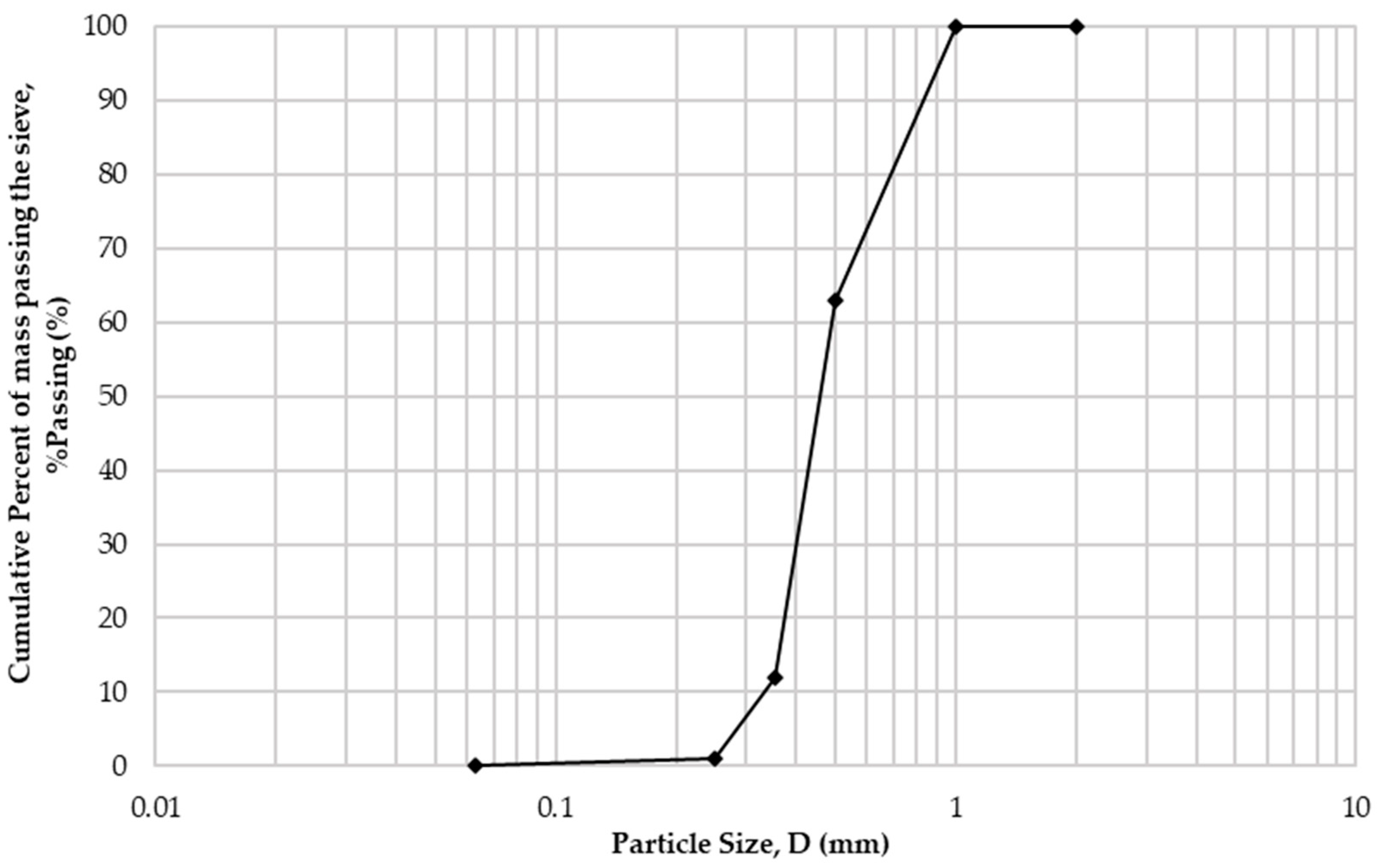

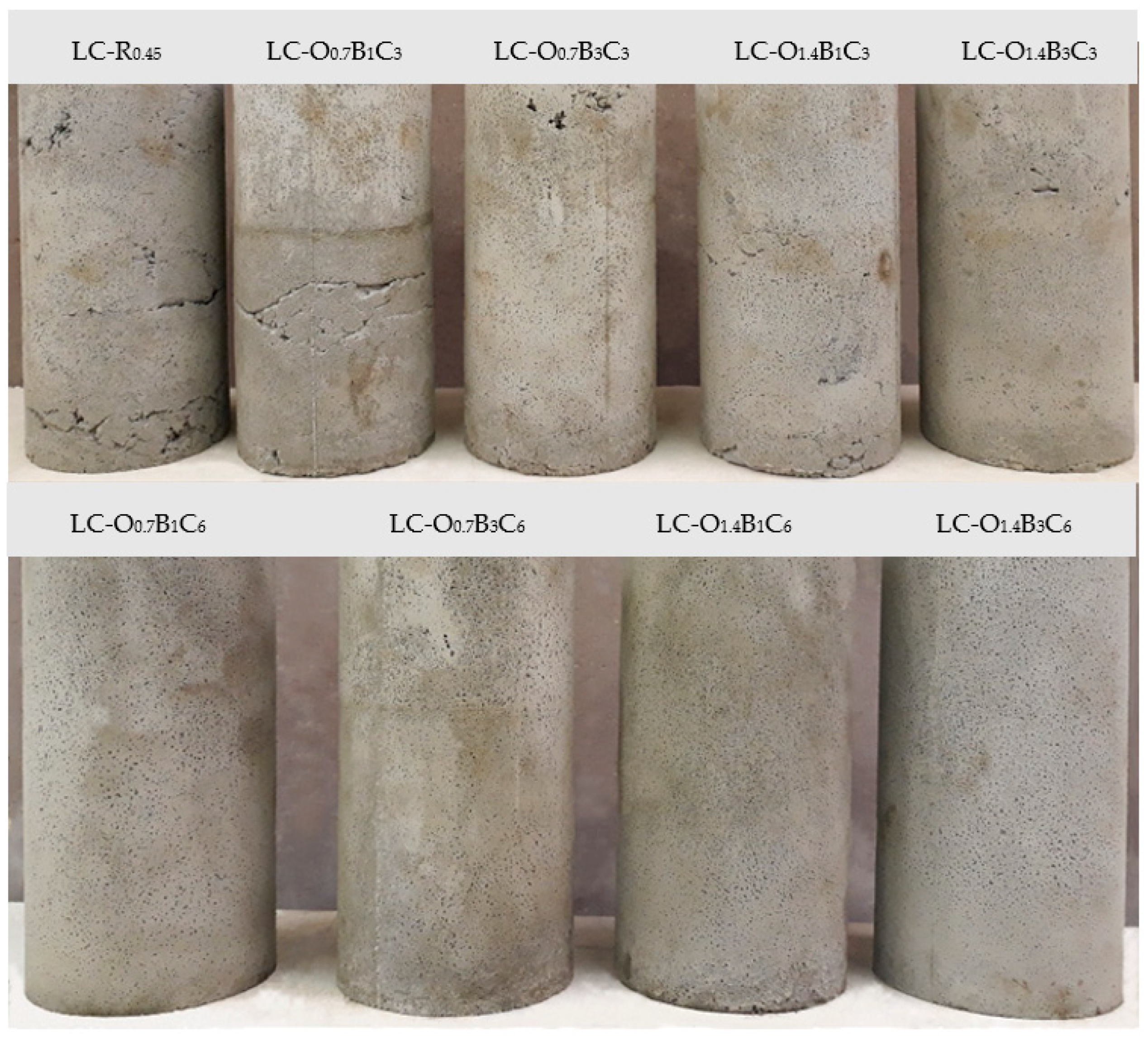
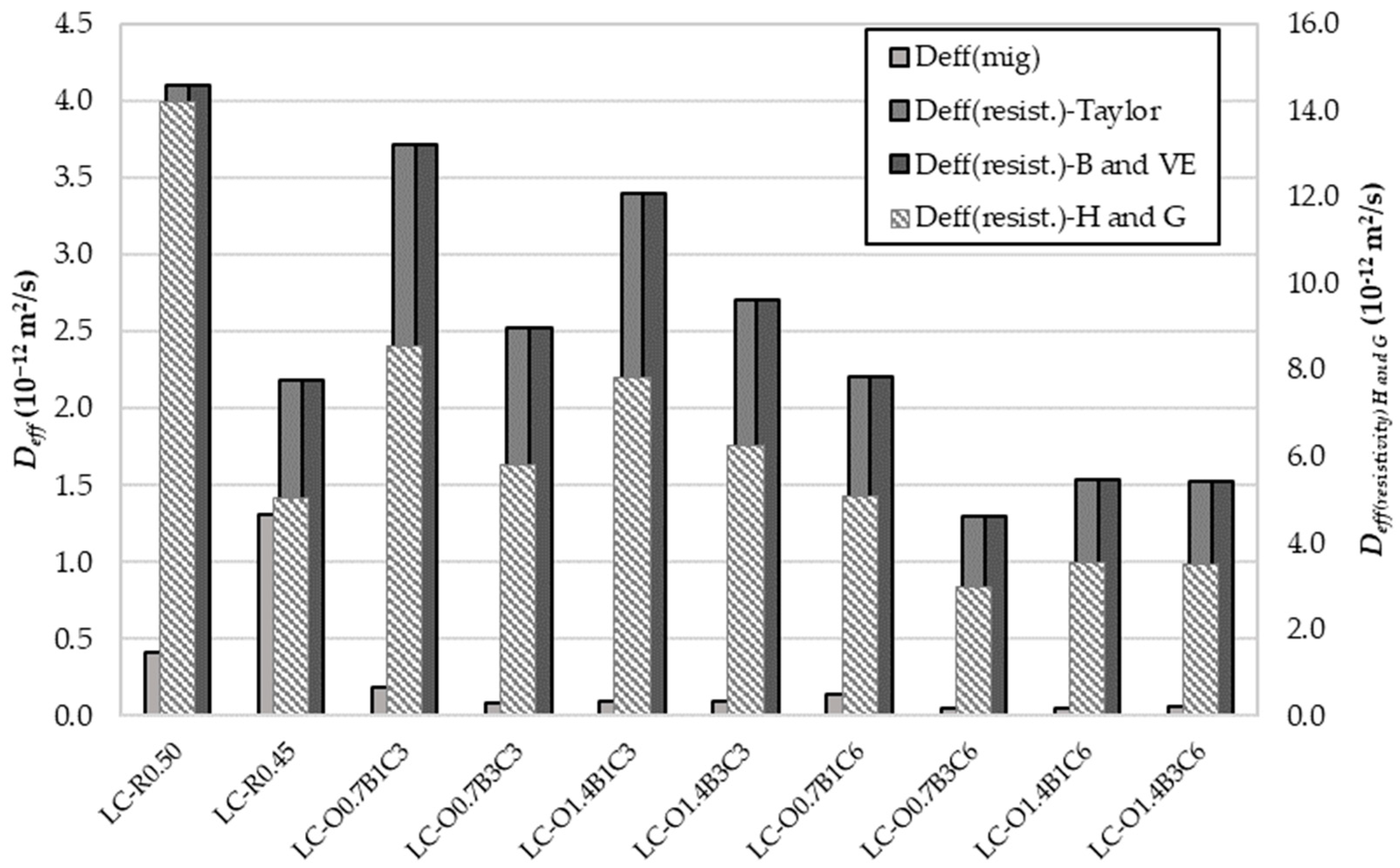

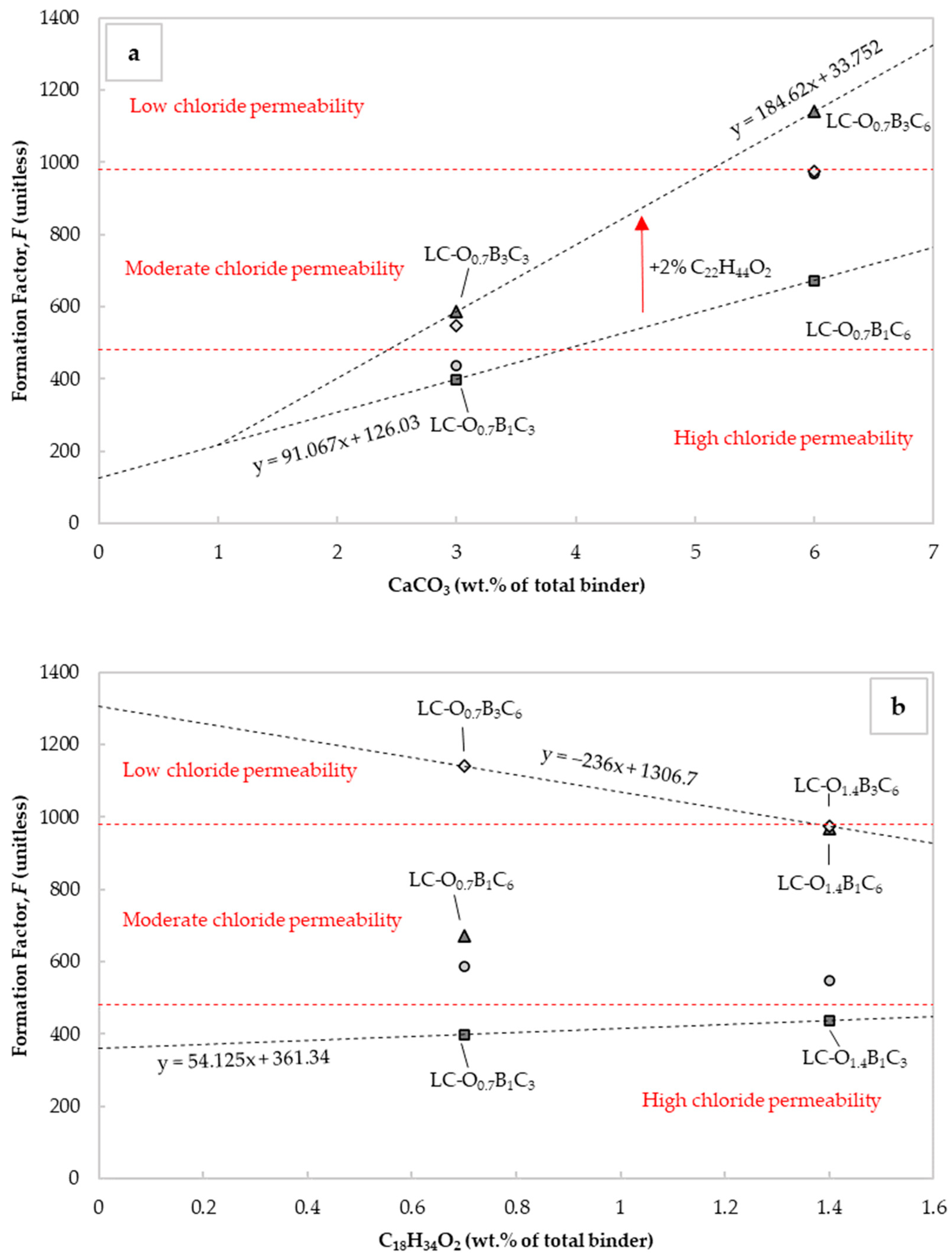



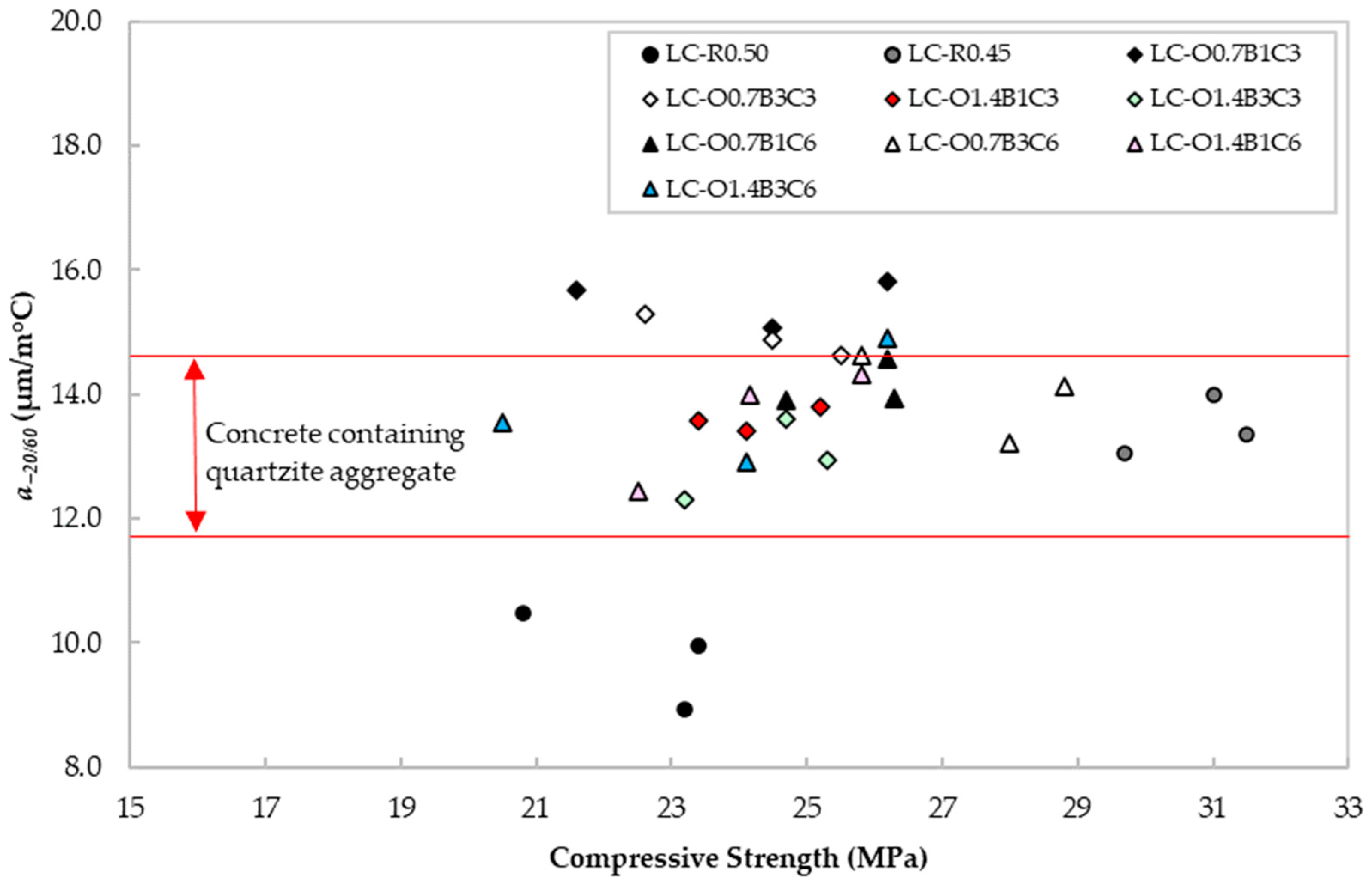
| CEM II A-L 32,5R | Sand | |
|---|---|---|
| Chemical components | ||
| CaO | 64.80 | <0.01 |
| SiO2 | 15.66 | 99.72 |
| Al2O3 | 4.03 | 0.07 |
| Fe2O3 | 2.78 | 0.05 |
| SO3 | 3.18 | - |
| MgO | 0.98 | 0.02 |
| K2O | 0.54 | 0.02 |
| Na2O | 0.11 | 0.04 |
| Free lime | 1.24 | - |
| Ignition loss | 7.76 | 0.05 |
| Alkali equivalent | 0.47 | - |
| Limestone | 16.8 | - |
| Mineralogical composition1 | ||
| C3S (%) | 69.4 | - |
| C2S (%) | 0.6 | - |
| C3A (%) | 6.0 | - |
| C4AF (%) | 8.3 | - |
| Mix Designation | Water (kg/m3) | Cement (kg/m3) | Sand (kg/m3) | Water to Cement Ratio (W/C) | Admixture (wt.% of Total Binder) | ||
|---|---|---|---|---|---|---|---|
| C18H34O2 | C22H44O2 | CaCO3 | |||||
| LC-R0.50 | 256 | 512 | 1535 | 0.50 | - | - | - |
| LC-R0.45 | 236 | 525 | 1575 | 0.45 | - | - | - |
| LC-O0.7B1C3 | 233 | 517 | 1551 | 0.45 | 0.7 | 1.0 | 3.0 |
| LC-O0.7B3C3 | 230 | 511 | 1532 | 0.45 | 0.7 | 3.0 | 3.0 |
| LC-O1.4B1C3 | 232 | 515 | 1545 | 0.45 | 1.4 | 1.0 | 3.0 |
| LC-O1.4B3C3 | 229 | 509 | 1526 | 0.45 | 1.4 | 3.0 | 3.0 |
| LC-O0.7B1C6 | 231 | 514 | 1543 | 0.45 | 0.7 | 1.0 | 6.0 |
| LC-O0.7B3C6 | 229 | 508 | 1524 | 0.45 | 0.7 | 3.0 | 6.0 |
| LC-O1.4B1C6 | 231 | 512 | 1536 | 0.45 | 1.4 | 1.0 | 6.0 |
| LC-O1.4B3C6 | 228 | 506 | 1519 | 0.45 | 1.4 | 3.0 | 6.0 |
| Time (Hours) | a (%) | |||||||
|---|---|---|---|---|---|---|---|---|
| Taylor | H and G | B and VE | Taylor | H and G | B and VE | |||
| a. Calculated pore solution based on a W/C ratio of 0.50 | ||||||||
| 0.01 | 0.0 | 1.00 | 24.85 | 24.95 | 24.85 | 126.11 | 126.11 | 126.11 |
| 1 | 1.4 | 0.97 | 26.25 | 25.96 | 26.25 | 131.33 | 129.88 | 131.33 |
| 16 | 19.1 | 0.62 | 54.43 | 43.87 | 54.43 | 235.83 | 191.02 | 235.83 |
| 27 | 30.4 | 0.39 | 99.35 | 61.85 | 99.36 | 402.43 | 252.97 | 402.45 |
| 64 | 34.9 | 0.30 | 135.26 | 71.24 | 135.27 | 535.58 | 285.56 | 535.63 |
| 158 | 36.9 | 0.26 | 159.32 | 76.07 | 159.34 | 624.82 | 302.38 | 624.89 |
| 311 | 38.2 | 0.24 | 180.31 | 79.60 | 180.35 | 702.70 | 314.71 | 702.78 |
| 615 | 40.1 | 0.20 | 218.50 | 84.83 | 218.55 | 844.34 | 332.98 | 844.47 |
| 1000 | 40.7 | 0.19 | 233.81 | 86.58 | 233.87 | 901.11 | 339.13 | 901.26 |
| b. Calculated pore solution based on a W/C ratio of 0.45 | ||||||||
| 0.01 | 0.0 | 1.00 | 27.61 | 27.61 | 27.61 | 140.13 | 140.13 | 140.13 |
| 1 | 1.4 | 0.97 | 29.27 | 28.90 | 29.27 | 146.40 | 144.60 | 146.40 |
| 16 | 19.1 | 0.58 | 64.93 | 50.45 | 64.94 | 281.33 | 219.81 | 281.34 |
| 27 | 30.4 | 0.32 | 133.45 | 73.55 | 133.46 | 540.53 | 301.37 | 540.57 |
| 64 | 34.9 | 0.23 | 201.99 | 86.26 | 202.04 | 799.87 | 346.63 | 799.97 |
| 158 | 36.9 | 0.18 | 257.22 | 92.97 | 257.29 | 1008.81 | 370.66 | 1008.99 |
| 311 | 38.2 | 0.15 | 313.27 | 97.96 | 313.38 | 1220.92 | 388.58 | 1221.18 |
| 615 | 40.1 | 0.11 | 440.63 | 105.47 | 440.84 | 1702.83 | 415.61 | 1703.37 |
| 1000 | 40.7 | 0.10 | 503.95 | 108.02 | 504.24 | 1942.47 | 424.85 | 1943.18 |
| Mix Design | Service Life (Years) | |
|---|---|---|
| a = 0.17 | a = 0.20 | |
| LC-R0.50 | 65 | 78 |
| LC-R0.45 | 34 | 43 |
| LC-O0.7B1C3 | 79 | 95 |
| LC-O0.7B3C3 | 112 | 135 |
| LC-O1.4B1C3 | 97 | 117 |
| LC-O1.4B3C3 | 110 | 133 |
| LC-O0.7B1C6 | 63 | 76 |
| LC-O0.7B3C6 | 132 | 159 |
| LC-O1.4B1C6 | 108 | 131 |
| LC-O1.4B3C6 | 115 | 139 |
Publisher’s Note: MDPI stays neutral with regard to jurisdictional claims in published maps and institutional affiliations. |
© 2022 by the authors. Licensee MDPI, Basel, Switzerland. This article is an open access article distributed under the terms and conditions of the Creative Commons Attribution (CC BY) license (https://creativecommons.org/licenses/by/4.0/).
Share and Cite
Malakopoulos, A.; Salifoglou, A. Assessment of Durability Indicators for Service Life Prediction of Portland Limestone Cementitious Systems Produced with Permeability-Reducing Admixtures. Buildings 2022, 12, 1712. https://doi.org/10.3390/buildings12101712
Malakopoulos A, Salifoglou A. Assessment of Durability Indicators for Service Life Prediction of Portland Limestone Cementitious Systems Produced with Permeability-Reducing Admixtures. Buildings. 2022; 12(10):1712. https://doi.org/10.3390/buildings12101712
Chicago/Turabian StyleMalakopoulos, Athanasios, and Athanasios Salifoglou. 2022. "Assessment of Durability Indicators for Service Life Prediction of Portland Limestone Cementitious Systems Produced with Permeability-Reducing Admixtures" Buildings 12, no. 10: 1712. https://doi.org/10.3390/buildings12101712
APA StyleMalakopoulos, A., & Salifoglou, A. (2022). Assessment of Durability Indicators for Service Life Prediction of Portland Limestone Cementitious Systems Produced with Permeability-Reducing Admixtures. Buildings, 12(10), 1712. https://doi.org/10.3390/buildings12101712








